Alright, let’s get straight to it—
Virtual events are no longer a trend—they’re a business staple. But let’s be real: Are they actually driving results, or just burning through your budget?
81% of event managers are hosting virtual events, and 92% call them successful. Yet most businesses struggle to measure real impact.
Sure, you can track registrations and attendance—but did your event generate revenue? Did it bring in high-quality leads? Or was it just another forgettable Zoom session?
Here’s the truth: Virtual event ROI isn’t about vanity metrics—it’s about proving results.
This guide breaks it all down:
✅ Track the right metrics (beyond headcounts)
✅ Boost engagement (so attendees don’t check out mid-session)
✅ Convert attendees into customers (because leads mean nothing without action)
✅ Repurpose content (so your event keeps delivering value)
If your virtual events aren’t moving the needle, it’s time to change the game. Let’s fix that. 🚀
Virtual Event Goals & KPIs: What You Should Measure

Measuring virtual event ROI isn’t about pulling random numbers from your event platform and calling it a day. If you don’t set clear goals and define the right performance indicators from the start, your post-event analysis will be a mess of disconnected data points that don’t tell a clear story.
What is the biggest mistake companies make? They treat virtual event measurement as an afterthought. ROI tracking isn’t something you do after the event—it starts long before the first attendee logs in.
So, how do you lay a solid foundation for accurate and meaningful virtual event ROI measurement? By following these three key steps:
- Defining Clear Goals: What business outcome are you aiming for?
- Identifying Key Performance Indicators (KPIs): What metrics matter for your specific event type?
- Ensuring Data Collection & Integration: How will you track and connect data across platforms?
Let’s break each of these down in detail.
1. Defining Your Goals: What Does Success Look Like?
Before you think about KPIs, analytics, and other key metrics to measure virtual event ROI, you need to define what success looks like for your event. The way you measure ROI depends entirely on your event’s purpose.
Ask yourself: What’s the primary goal of this virtual event?
✅ Lead Generation & Pipeline Growth: Is the goal to generate marketing-qualified leads (MQLs) or move prospects closer to a sale?
✅ Revenue & Direct Sales: Is this event tied to an offer, upsell, or product launch?
✅ Brand Awareness & Thought Leadership: Is success measured in reach, engagement, and brand sentiment?
✅ Customer Education & Product Adoption: Are you aiming to increase feature adoption, reduce churn, or strengthen customer loyalty?
Each goal requires different measurement strategies.
Example: Virtual Conference vs. Webinar ROI Goals
| Event Type | Primary Goal | ROI Focus |
|---|---|---|
| Virtual Summit | Thought leadership, brand authority | Brand sentiment, social reach, media mentions |
| Lead Gen Webinar | Generating sales leads | Registrations, MQLs, pipeline influence |
| Product Demo | Driving direct sales or free trial signups | Conversion rate, customer acquisition cost (CAC) |
| Customer Training | Reducing churn, improving customer retention | Feature adoption, customer retention rate |
Pro Tip: One event can have multiple goals, but prioritize one primary objective to guide your measurement framework.
Real-World Example: A SaaS company hosts a virtual product launch with two goals:
- Increase awareness among potential buyers (measured by social shares and press coverage).
- Drive direct sales of the new product (measured by event-driven purchases).
Without separating these objectives, their ROI analysis would be confusing. They need different KPIs and tracking methods for each goal.
2. Identifying Key Performance Indicators (KPIs)
Once you have a clear goal, the next step is identifying the right performance indicators to measure success.
The mistake most companies make? They track generic metrics (like registration numbers) instead of focusing on the ones that truly indicate business impact.
Breakdown of Virtual Event KPIs by Event Stage
| Stage | Key Metrics |
|---|---|
| Pre-Event | Registration rate, source of registrations, ad performance (if applicable) |
| During Event | Attendance rate, audience retention, engagement (polls, Q&A, networking) |
| Post-Event | Lead conversion rate, pipeline influence, revenue impact, brand sentiment |
Let’s break it down further.
1. Pre-Event KPIs: Measuring Demand & Audience Fit
Why it matters: A high number of registrations means nothing if those people aren’t the right audience.
✅ Registration Metrics:
- Total sign-ups – Basic but necessary.
- Conversion rate of landing page visitors to registrants – If it’s below 20-30%, your messaging or sign-up process may need improvement.
- Source of registrations – Track where sign-ups are coming from (email, LinkedIn, paid ads, referrals).
- Sign-Up Rate – Calculate the number of sign-ups divided by the total unique visitors to measure how effective your landing page is.
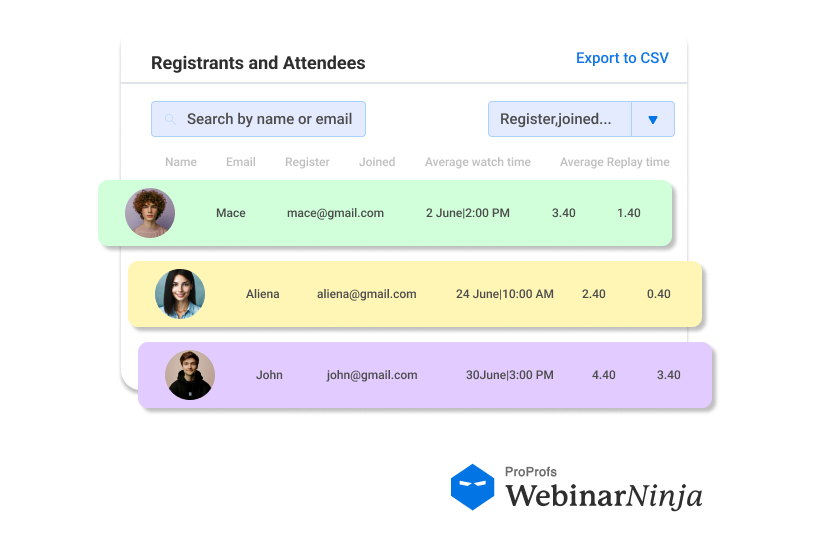
Example: If 50% of your registrations come from LinkedIn but only 5% convert to customers, you may need better targeting or messaging.
2. During Event KPIs: Engagement & Retention
Why it matters: A virtual event is only valuable if people actually show up and participate.
✅ Attendance Metrics:
- Live attendance rate – How many registrants actually attended? A 40-60% attendance rate is typical.
- On-demand views – If your event is recorded, how many watch later?
- Drop-off rate – How long do people stay before leaving?
- Unique Visits vs Registrants – Measure the number of unique visitors to the registration page compared to how many actually registered.
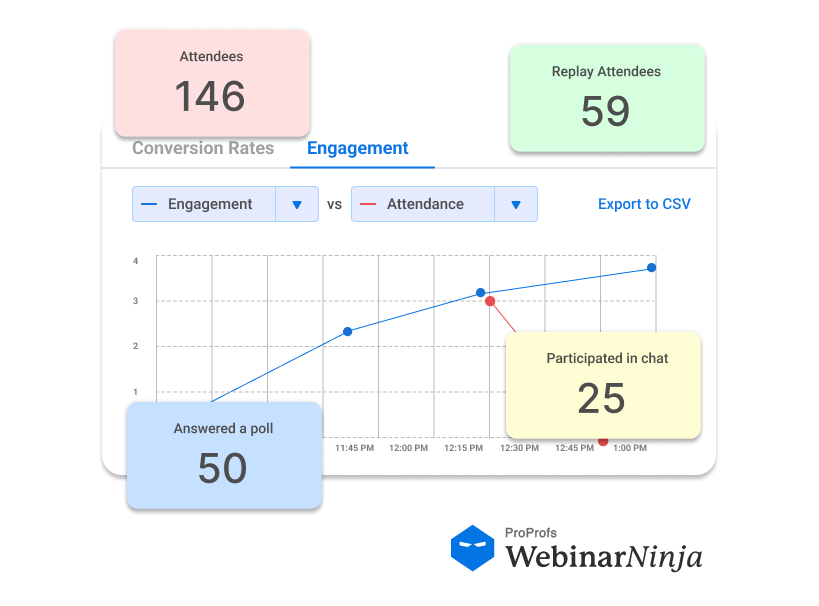
✅ Engagement Metrics:
- Chat & Q&A participation – High engagement = high intent.
- Poll response rate – If only 5% of attendees respond, your content might not be engaging enough.
- Networking interactions – Are attendees actively engaging in networking sessions or breakout rooms?
Example: A company hosts a virtual roundtable discussion with 200 attendees. Only 10% ask questions. This suggests low engagement—perhaps the session was too passive or lacked interactive elements.
Solution: Add live Q&A, breakout sessions, or audience-driven topics to boost engagement.
3. Post-Event KPIs: Measuring Business Impact
Why it matters: The real ROI happens after the event. This is where most companies fail to track long-term impact.
✅ Lead Generation & Sales Metrics:
- Number of qualified leads generated – Not just registrations, but leads that match your ideal customer profile (ICP).
- Conversion rate from event attendees to sales opportunities – Are attendees actually entering your pipeline?
- Customer acquisition cost (CAC) – How much did it cost to acquire customers from the event?
- Offer Click Rate – Measure how many attendees clicked on your offer during the event.
✅ Brand Awareness & Perception Metrics:
- Social media mentions & shares – Is the event driving conversations beyond your platform?
- Website traffic spikes – Did post-event content (blogs, replays) drive more visits?
- Survey results (Net Promoter Score) – How did attendees feel about the event?
Example: A B2B healthcare company runs a virtual summit with 5,000 attendees. Two weeks later, their website traffic is 80% higher than usual—a clear sign that the event increased brand awareness.
3. Ensuring Data Collection & Integration
Having great KPIs means nothing if you can’t track them accurately.
How to Ensure Accurate Data Collection:
✅ Use virtual event platforms with built-in analytics – Tools like WebinarNinja provide engagement and retention insights.
✅ Integrate your CRM (BigContacts, HubSpot, Zoho, etc.) – This ensures leads don’t get lost post-event.
✅ Use UTM parameters & tracking links – Helps you attribute registrations and traffic to specific campaigns.
✅ Post-event surveys – Capture qualitative insights that aren’t reflected in the numbers.
Example: A fintech company integrates WebinarNinja + HubSpot + LinkedIn Ads. They track:
- How many leads from the event entered their CRM
- Which marketing campaign drove the most high-value registrants
- How many attendees booked sales meetings post-event
Result? They optimize future events based on real audience behavior.
By defining clear goals, selecting the right KPIs, and ensuring data flows seamlessly across platforms, businesses can finally measure real business impact—not just vanity metrics.
In the next section, we’ll dive into practical ROI measurement strategies and formulas—from basic ROI calculations to advanced revenue attribution models.
How to Measure Virtual Event ROI: Strategies and Formulas
Now that you’ve defined your goals and identified the right KPIs, it’s time to put those numbers to work and measure the actual return on investment (ROI) of your virtual event.
If you’re wondering how to calculate virtual event ROI, the key is to move beyond surface-level metrics and establish a direct link between engagement and business outcomes.
This section will break down how to gather data, apply ROI formulas, and track revenue-driven metrics to get a clear picture of your virtual event’s success.
1. Gathering Data: What You Need to Measure ROI
Before you can calculate ROI, you need complete and connected data across event platforms, marketing tools, and CRM systems.
Key Data Sources for Virtual Event ROI Measurement:
✅ Virtual Event Platform Analytics
- Registration and attendance rates
- Engagement metrics (polls, Q&A, networking activity)
- Session duration and drop-off rates
✅ Marketing Analytics
- Website traffic spikes before and after the event
- Lead sources: Where did registrations come from?
- Post-event email open and click-through rates
✅ Sales & CRM Data
- Number of leads generated from the event
- How many leads converted into customers
- Sales pipeline impact and deal closure rates
✅ Social Media & Brand Metrics
- Event-related social media mentions and shares
- LinkedIn engagement and post-event conversations
- Content downloads (whitepapers, eBooks) post-event
✅ Survey & Feedback Data
- Net Promoter Score (NPS) to gauge attendee satisfaction
- Qualitative feedback on event experience and brand perception
Example: A global HR tech company hosts a virtual networking event and tracks:
- Pre-event marketing performance: Where did attendees come from?
- Live engagement data: How many attendees actively participated?
- Post-event impact: How many attendees turned into sales-qualified leads (SQLs)?
The result? A 360-degree view of virtual event ROI instead of just focusing on vanity metrics like attendance.
2. Simple ROI Formulas: Measuring Direct Financial Impact
The easiest way to measure webinar ROI is with a basic formula that compares the revenue generated against the costs incurred.
Formula: Basic ROI Calculation
| ROI = ((Revenue Generated − Event Costs) / Event Costs) × 100 |
Example:
- Revenue generated from webinar: $50,000
- Total cost of webinar (ads, software, production, speaker fees, etc.): $10,000
- ROI Calculation:
ROI = ((50,000 − 10,000) / 10,000) × 100 = 400%
A 400% ROI means that for every $1 spent on the webinar, you made $4 in return.
3. Going Beyond Simple ROI: Revenue Attribution Models
Most virtual events don’t drive instant revenue—instead, they influence the sales pipeline over time. That’s where advanced revenue attribution models come in.
1. Lead-to-Sales Conversion Rate
What It Measures: How many event-generated leads turn into paying customers?
| Lead Conversion Rate = (Total Leads Converted / Total Webinar Leads) × 100 |
Example: A SaaS company gets 800 webinar attendees, and 200 of them turn into marketing-qualified leads (MQLs). Out of those, 40 book demos and enter the sales pipeline.
Lead Conversion Rate = (40 / 200) × 100 = 20%
If your conversion rate is low, it could indicate a misalignment between webinar content and audience expectations.
2. Customer Acquisition Cost (CAC) per Virtual Event
What It Measures: How much it costs to acquire a customer through a webinar.
| CAC = Total Event Cost / Number of New Customers |
Example:
- Event cost: $15,000
- Customers acquired: 30
CAC per Event: 15,000 / 30 = $500 per customer
Comparing this to your usual CAC will help you determine if events are a cost-effective customer acquisition channel.
3. Customer Lifetime Value (LTV) of Webinar Attendees
What It Measures: The long-term revenue potential of customers acquired through events.
| LTV = Average Revenue per Customer × Average Customer Lifespan |
If event-driven customers have a higher LTV than other customers, it proves that virtual events attract high-value buyers.
4. Pipeline Influence: Tracking Indirect Revenue Impact
Many virtual events don’t directly lead to sales but play a role in influencing pipeline deals.
Example: A tech company hosts a virtual product demo and tracks its influence on deals over six months:
- 300 attendees join the demo.
- 100 attendees book sales calls.
- 50 enter the sales pipeline.
- 20 deals close, generating $500,000 in revenue.
| Pipeline Influence Rate = (Influenced Deals / Total Deals) × 100 |
If a significant portion of your closed deals were event attendees, your event played a critical role in sales.
4. Attribution Models: Giving Webinars Credit Where It’s Due
How do you know if a virtual event really contributed to revenue? Attribution models help assign revenue credit to different marketing touchpoints.
✅ First-Touch Attribution – Gives full credit to the event if it was the first interaction before a prospect entered the funnel.
✅ Last-Touch Attribution – Assigns full credit if the event was the final step before the sale.
✅ Multi-Touch Attribution – Divides credit across all interactions leading up to the sale (webinar, emails, demos, sales calls).
If your virtual event was part of a longer sales journey, multi-touch attribution is the most accurate way to measure ROI.
Example: A B2B SaaS company runs a virtual workshop that 500 leads attend. Three months later:
- 200 leads book sales calls.
- 80 enter the sales pipeline.
- 30 deals close.
- The company assigns 50% of the revenue credit to the event.
| Attribution Credit = Revenue × Attribution Percentage |
If the total revenue from closed deals is $600,000, then:
Attribution Credit = 600,000 × 50% = 300,000
This means the virtual event influenced $300,000 in revenue, even if it wasn’t the final touchpoint.
In the next section, we’ll explore a qualitative view of virtual event ROI and how it ensures long-term success.
Beyond the Numbers: Qualitative ROI and Long-Term Value
Not all ROI can be captured in spreadsheets. While registration numbers, sales conversions, and lead metrics tell part of the story, the true impact of virtual events often extends beyond the numbers.
Here’s a quick table that helps you understand the difference between qualitative and quantitive analysis of ROI:
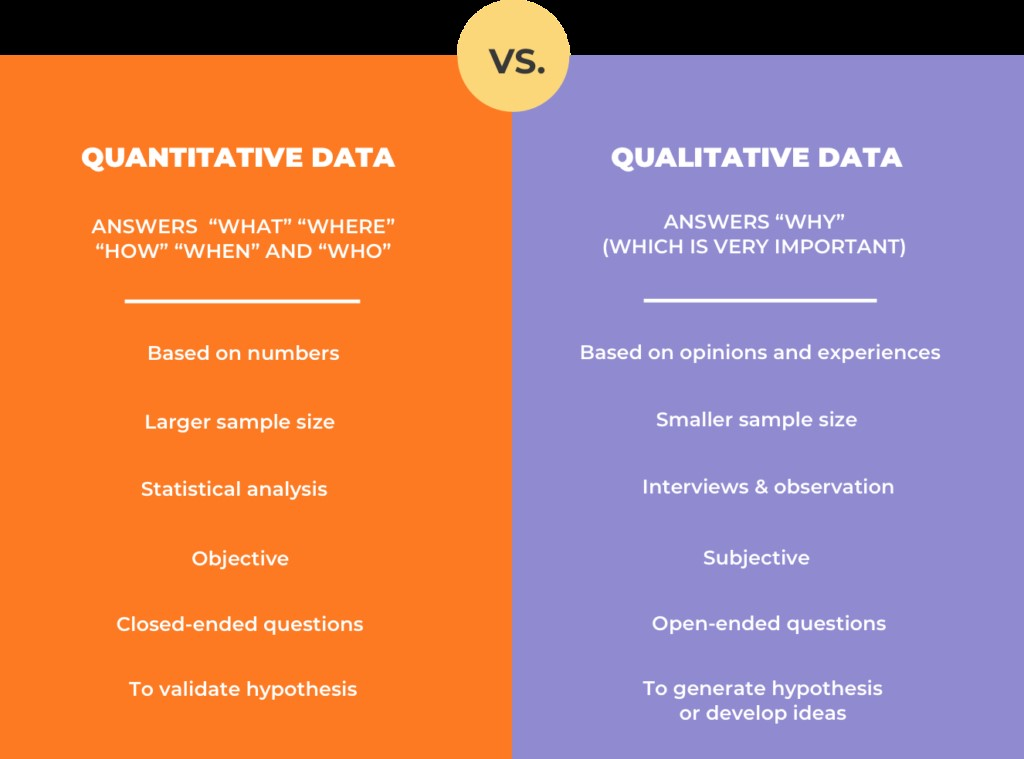
(Image Source: CGS)
Brand perception, customer loyalty, and thought leadership—these factors might not generate immediate revenue, but they shape long-term business success. A virtual event that fosters trust, strengthens relationships, and positions your brand as an industry leader has a value that goes beyond a single deal or transaction.
So, how do you measure and maximize the qualitative ROI of virtual events? Let’s break it down.
1. Building Brand Authority and Thought Leadership
Virtual events are one of the most effective ways to position your company as an authority in your industry. When done well, they can establish credibility, attract media attention, and strengthen your reputation—leading to long-term business growth.
How Virtual Events Build Brand Authority:
✅ Showcasing Expertise – Hosting a virtual summit, panel discussion, or keynote event featuring industry leaders reinforces your brand’s thought leadership.
✅ Leveraging Influencers & Partners – Collaborating with respected industry figures elevates your brand’s trust and reach.
✅ Consistently Providing Value – Educational events, training sessions, and fireside chats position your brand as a go-to source for insights and solutions.
Example: A fintech startup hosts a virtual roundtable discussion with top banking executives. The event attracts media coverage and LinkedIn discussions, expanding the brand’s reach by 300% and increasing inbound partnership inquiries.
How to Measure It:
📊 Brand Sentiment Surveys – Ask attendees: “Did this event change your perception of our brand?”
📊 Media & PR Mentions – Track event mentions in industry news, blogs, and social media.
📊 Follower & Engagement Growth – Monitor increases in LinkedIn connections, Twitter mentions, and website visits post-event.
2. Strengthening Customer Relationships and Loyalty
A virtual event isn’t just a lead generation tool—it’s an opportunity to engage existing customers, reinforce trust, and build loyalty.
How Virtual Events Strengthen Customer Relationships:
✅ Direct Interaction – Live Q&A, networking sessions, and roundtables allow customers to connect with your brand on a deeper level.
✅ Exclusive Access – VIP-only events, AMAs (Ask Me Anything), and private workshops make customers feel valued.
✅ Education & Enablement – Product training, onboarding webinars, and customer success events improve retention and reduce churn.
Example: A SaaS company organizes a customer-exclusive virtual workshop showcasing advanced use cases of their software. The event boosts feature adoption by 40% and reduces customer churn by 15% over six months.
How to Measure It:
📊 Customer Retention Rate – Compare retention rates between event attendees vs. non-attendees.
📊 Net Promoter Score (NPS) – Post-event surveys can gauge customer satisfaction and brand loyalty.
📊 Product Adoption Metrics – Track feature usage before and after the event to see if customers become more engaged.
3. Gathering Market & Customer Insights
Want to know what your audience truly cares about? Virtual events are a goldmine for market research and customer insights.
How Virtual Events Help with Market Research:
✅ Live Polls & Q&A = Direct Customer Feedback – You get real-time insights into customer pain points, challenges, and interests.
✅ Behavioral Data = What Attendees Care About – Which sessions had the highest engagement? Which topics led to the most questions?
✅ Audience Segmentation – Virtual event data helps categorize attendees into potential buyers, existing customers, and advocates.
Example: A healthcare company notices that during their virtual summit on digital health, 70% of attendees engage most with sessions related to AI-powered diagnostics. This insight helps them prioritize AI features in their next product roadmap.
How to Measure It:
📊 Poll & Q&A Participation Rates – What percentage of attendees engaged with interactive elements?
📊 Drop-Off Analysis – Which sessions had the highest vs. lowest retention?
📊 Follow-Up Behavior – Which attendees downloaded resources, booked demos, or continued engagement post-event?
4. Educating & Nurturing Leads for Long-Term Sales Impact
Not all event-generated leads convert immediately—many take months or even years before making a buying decision. But if you’ve educated and nurtured them properly, your event will play a critical role when they’re ready to purchase.
Here’s a quick representation of a step-by-step process of nurturing a lead:
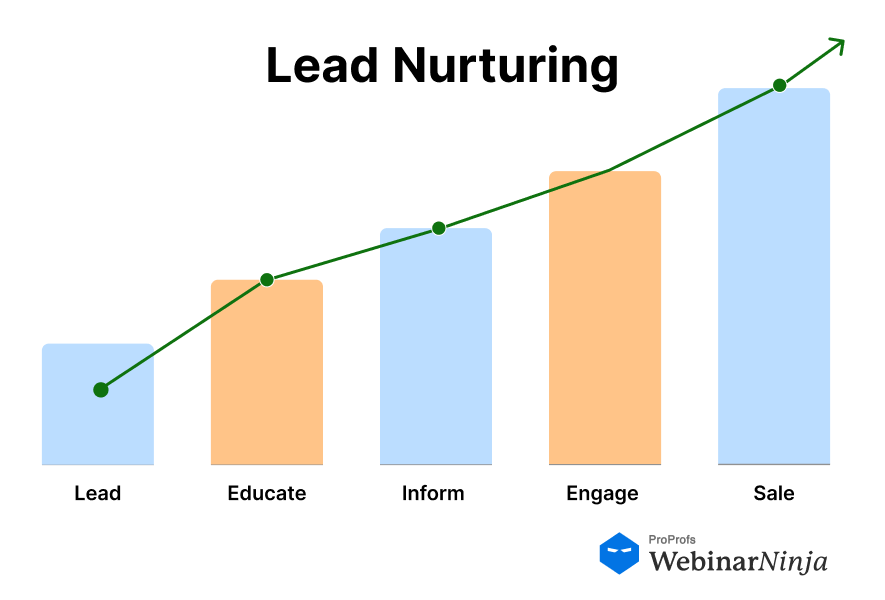
How Virtual Events Nurture Leads Over Time:
✅ Post-Event Content Keeps Engagement Alive – Webinar recordings, event highlight clips, and session recaps extend the event’s influence.
✅ Email Drip Campaigns Reinforce Key Messages – Following up with attendees using personalized emails strengthens the relationship.
✅ Retargeting Ads Keep You Top-of-Mind – Serving ads and reminders to event attendees increases conversion likelihood.
Example: A B2B cybersecurity company tracks attendees from a virtual threat intelligence conference. While only 5% convert within a month, an additional 20% become customers over the next 12 months.
How to Measure It:
📊 Lead Progression in CRM – Track how event attendees move through the sales funnel over time.
📊 Retargeting Click-Through Rates – Are attendees engaging with post-event ads and follow-ups?
📊 Event-Influenced Deals Closed – How many deals included an event touchpoint in the buyer’s journey?
5. Leveraging Virtual Events for Employer Branding & Talent Acquisition
Virtual events don’t just attract customers—they can position your company as an attractive employer and help recruit top talent.
How Virtual Events Contribute to Talent Acquisition:
✅ Industry Events Showcase Company Culture – Webinars, summits, and fireside chats help attract job seekers who align with your mission.
✅ Employee-Led Panels Demonstrate Thought Leadership – Featuring your employees in public speaking roles enhances employer branding.
✅ Networking & Career Sessions Bring in Top Candidates – Hosting virtual career fairs or Q&A sessions attracts qualified job applicants.
Example: A global tech firm hosts a virtual innovation summit showcasing their AI research. As a result, applications for data science roles increase by 60% in the following three months.
How to Measure It:
📊 Career Page Traffic Spikes Post-Event
📊 Increase in Job Applications from Event Attendees
📊 Employer Brand Mentions on Social Media
If your event boosts brand credibility, strengthens relationships, and nurtures long-term customer engagement, then it’s already delivering ROI—even if the revenue impact isn’t immediate.
Let’s now check out the major issues that businesses face related to event ROIs and why most of them get it wrong.
Why Most Businesses Get It Wrong
Virtual events generate scattered data across platforms, making ROI hard to track. Unlike in-person events with clear success metrics, businesses struggle to measure real impact.
It’s not just about attendee counts—ROI means proving business value in brand growth, lead generation, and revenue.
Here’s where most companies go wrong.
1. Difficulty in Measuring ROI
The biggest challenge? There’s no single, universal way to measure virtual event ROI. Unlike physical events, where success is often tied to ticket sales or sponsorship revenue, virtual events produce a mix of direct and indirect outcomes.
For instance, a virtual trade show might lead to hundreds of conversations, brand exposure, and long-term business relationships, but how do you quantify that impact in hard numbers? If you host an industry panel discussion, how do you measure its influence on customer trust or future purchase decisions?
Solution: Companies need to define their virtual event ROI based on multiple dimensions, not just short-term revenue. This includes lead generation, brand awareness, customer engagement, and long-term business influence.
2. Fragmented Data and Lack of Standardization
One of the biggest barriers to ROI measurement? Virtual event data is all over the place. Most businesses rely on multiple tools to manage and track event performance:
- Event registration platforms (Eventbrite, Cvent, Hopin)
- Webinar software (WebinarNinja, Zoom)
- Marketing automation tools (HubSpot, Marketo, Pardot)
- CRMs (BigContacts, Zoho, Microsoft Dynamics)
Each platform collects different types of data, and without seamless integration, companies struggle to see the full picture.

Example: A company hosts a virtual product launch and captures attendee data in Zoom, engagement insights in Slido, and follow-up email clicks in HubSpot. But their sales team in Salesforce has no easy way to connect these data points and track actual conversions.
Solution: Businesses need data integration strategies—either through event platforms that sync with their CRM or custom dashboards that consolidate key event metrics into a single view. When you use an all-in-one webinar tool like WebinarNinja, you can get access to all the data and conversions right within the tool.
Here’s a quick video that helps you understand how WebinarNinja can track your webinar replays and other data:
3. Proving Value to Stakeholders
Executives don’t care about how many people attended your virtual event. They care about its impact on revenue, pipeline growth, and customer retention. The challenge? Many marketing and event teams fail to translate engagement metrics into business outcomes.
Stakeholders typically ask:
- Did this event bring in high-value leads that turned into paying customers?
- How does this compare to other marketing channels?
- What’s the long-term brand and relationship impact?
If your post-event report only includes vanity metrics (like attendee numbers or social media shares), you’ll struggle to justify future investments in virtual events.
Example: A financial services firm hosts a global virtual summit. They present a post-event report showing 10,000 attendees and 5,000 LinkedIn mentions. Impressive? Maybe. But without proof that these attendees converted into actual sales opportunities, the executive team remains skeptical.
Solution: Instead of focusing on raw numbers, frame virtual event ROI in terms of business impact:
✅ “This event generated 500 qualified leads, 60% of whom fit our target customer profile.”
✅ “50% of attendees downloaded our post-event whitepaper, signaling strong purchase intent.”
✅ “By repurposing event content into blogs and videos, we increased website traffic by 200%.”
4. Determining the Right KPIs for Virtual Events
What is the reason many companies struggle with ROI measurement? They track the wrong KPIs. A networking-focused event isn’t measured the same way as a lead-generation webinar.
According to a study by Markletic, the rate of success of a virtual event can vary according to the graph below:

Besides, here’s how virtual event KPIs vary by event type:
- Thought Leadership Events (Panels, Keynotes, Industry Summits) → KPIs: Brand sentiment, audience retention, content engagement
- Lead Generation Events (Webinars, Product Demos, Sales Conferences) → KPIs: Registrations, conversion rates, sales pipeline influence
- Customer Education & Training (Workshops, Virtual Certifications) → KPIs: Feature adoption, support ticket reduction, customer retention rates
Example: A SaaS company runs a virtual customer training event. Their mistake? Measuring success based on attendance alone. The real impact is seen in post-event product adoption rates—which increased by 35% among attendees.
Solution: Companies need to align event KPIs with their business goals and ensure they track the right success metrics for each event type.
5. Engagement vs. Business Impact: The Misalignment Problem
Virtual events often see high engagement—but does engagement translate into business value? Many organizations assume polls, chats, and session views equal to good webinar ROI. But if attendees never move down the funnel, those metrics aren’t enough.
Example: A marketing agency hosts a virtual networking event that sees 1,000 chat messages exchanged. Success? Not quite—because only 5% of attendees actually book follow-up meetings with the sales team.
Solution: Companies need to ensure engagement leads to action. This means using:
✅ Post-event nurturing – Sending personalized follow-ups based on attendee behavior.
✅ Clear CTAs – Ensuring every virtual session directs attendees toward the next step (demo, consultation, content download).
✅ Lead scoring – Identifying high-intent attendees based on interactions and passing them to sales.
Here’s an expert insight on how to interact with your audience, if you use webinars for virtual events:
6. Understanding Long-Term ROI and Pipeline Influence
Unlike in-person trade shows, where deals close on the spot, virtual events often influence the pipeline months later. The problem?
Many businesses stop tracking ROI too soon, overlooking the importance of measuring virtual event ROI beyond the immediate aftermath. Without long-term tracking, they miss valuable insights into how these events contribute to revenue and growth.
Example: A B2B tech company hosts a virtual roundtable discussion. No immediate sales. But six months later, 20% of attendees turn into customers. If the company had only measured immediate post-event sales, they would have undervalued the event’s impact.
Solution: Companies should use multi-touch attribution models to track how virtual events contribute to revenue over time.
- First-touch attribution: Gives full credit to the event if it was the first interaction with a lead.
- Last-touch attribution: Assigns credit if the event was the final step before a purchase.
- Multi-touch attribution: Divides credit across all interactions leading up to the sale (email, webinar, sales calls, etc.).
Strategies to Maximize Virtual Event ROI
Measuring virtual event ROI is one thing—maximizing it is another. If you’re not optimizing every stage of your event, you’re leaving money and impact on the table.
A virtual event isn’t just a one-time experience—it’s a multi-stage business asset. The best companies extract maximum value from their events by strategically planning, engaging attendees, and ensuring that post-event momentum leads to real business outcomes.
If you are looking for strategies on how to improve ROI for virtual events to turn them into a revenue-generating powerhouse, follow these strategies.
1. Strategic Planning and Budget Allocation: Spend Smarter, Not More
Many companies fail at virtual events not because of bad content but because they spend money in the wrong places.
Some organizations invest heavily in production and branding, only to realize they didn’t allocate resources for follow-up and lead nurturing. Others pour money into advertising without ensuring the registration and event experience are seamless.
How to Allocate Your Virtual Event Budget Wisely
- Prioritize promotion efforts that focus on audience targeting rather than broad ad spending.
- Focus on content and speaker quality rather than production-heavy elements that don’t impact engagement.
- Allocate a portion of the budget specifically for post-event follow-up, nurturing, and lead tracking.
Pro Tip: If your event budget doesn’t include a follow-up strategy, you’re essentially spending money to generate leads and then ignoring them. The highest ROI often comes after the event, not during it.
2. Engaging Content and Delivery: Keep Attendees Hooked
A virtual event needs to do more than just deliver information—it must hold the audience’s attention. A lack of engagement leads to higher drop-off rates, reducing the effectiveness of the event.
How to Make Virtual Events More Engaging
- Avoid one-way communication by incorporating interactive elements such as live polls, breakout rooms, and Q&A sessions.
- Keep presentations concise and focused, ensuring sessions are structured in a way that maintains energy and engagement.
- Use multiple speakers or panel discussions to bring in different perspectives and keep discussions dynamic.
- Encourage real-time participation by prompting attendees to share thoughts or respond to questions early in the session.
Pro Tip: If your audience is multitasking or checking emails during your event, you’ve already lost them. Keep them engaged by using questions, interactive elements, and real-time feedback.
3. Seamless Registration and Attendee Experience: Don’t Make It Hard to Attend
A complicated registration process or difficult event access can significantly impact attendance. If the experience is confusing or requires too many steps, potential attendees may drop off before the event even begins.
Here’s how easy it is to register for a webinar on Webinarninja:
How to Simplify Registration and Improve Attendee Experience
- Implement one-click registration through social logins or pre-filled forms to minimize effort for attendees.
- Ensure automated event reminders are sent at regular intervals to keep attendance rates high.
- Provide clear joining instructions and make the process as seamless as possible.
- Optimize for mobile access to accommodate attendees who may join from different devices.
Pro Tip: If attendees need to search their inbox for an access link minutes before the event, you’ve already lost half your audience. Make access instant and effortless.
4. Effective Marketing and Promotion: Get People to Actually Show Up
Registrations do not always equal attendance. Even after sign-ups, people need reminders and compelling reasons to actually show up for the event.
How to Get More People to Attend
- Use email and social media promotion together, ensuring consistent messaging across different channels.
- Highlight exclusive aspects of the event, such as live Q&A sessions or limited-time access to industry leaders.
- Leverage the networks of event speakers or panelists to extend promotional reach.
- Retarget those who have visited the event landing page but have not yet registered.
Pro Tip: People sign up for events with good intentions but often forget. Multiple touchpoints—emails, calendar invites, and LinkedIn reminders—ensure your event stays on their radar.
Here’s a quick insight on how to market your webinars and other virtual events like an expert:
5. Optimizing for Lead Generation and Follow-Up: The Fortune Is in the Follow-Up
Virtual events are only valuable if they result in action. Attendees who engaged during the event but were not followed up with may quickly forget about the experience.
How to Convert Attendees into Sales Opportunities
- Segment attendees based on their engagement levels and prioritize high-intent leads for immediate outreach.
- Ensure follow-up begins within 48 hours while the event is still fresh in attendees’ minds.
- Provide a clear next step, whether it’s a meeting booking, product demo, or exclusive post-event offer.
- Develop a post-event content funnel that keeps leads engaged over time.
Pro Tip: Attendees who ask questions, engage in chat, or download resources are your warmest leads. Follow up with them first before moving on to passive participants.
6. Repurposing Virtual Event Content: Keep the ROI Going
A virtual event shouldn’t end when the live session is over. The content created can be reused across multiple platforms to continue delivering value long after the event has concluded.
How to Repurpose Virtual Event Content
- Offer a gated replay of the event to capture additional leads.
- Break down the event into short video clips and share them across social media channels.
- Publish a written recap or key takeaways article to maximize reach.
- Use post-event content in automated nurture sequences to maintain engagement with attendees.
Pro Tip: If your virtual event content only lives for the duration of the event, you’re missing out on long-term engagement. Repurpose, redistribute, and extend its lifespan.
Case Studies: Real-World Examples of Maximizing Virtual Event ROI
The best way to understand how to maximize ROI for virtual events is to see them in action. Many businesses have successfully leveraged virtual events to generate leads, drive revenue, and enhance brand authority.
Here are a few case studies to help you understand things better.
Case Study 1: 200% growth in qualified leads with WebinarNinja, with one session bringing in $20,000-$25,000
Sales Market Fit, a consulting firm helping businesses improve their sales processes, wanted to generate consistent, high-quality leads without relying on cold outreach. The company needed a strategy that would attract and engage their ideal clients while reducing the time spent on one-on-one sales calls.
The Strategy
- Shifted from Individual Sales Calls to Webinars – Instead of conducting one-on-one calls, the company launched interactive webinars that educated potential clients at scale.
- Created a Structured Webinar Funnel – The webinars were designed to qualify leads upfront, ensuring that only serious prospects progressed to sales conversations.
- Optimized for Engagement and Retention – To keep attendees interested, the webinars featured live Q&A sessions, interactive elements, and high-value content.
- Implemented a Strong Follow-Up System – Attendees who engaged in the webinars received personalized follow-ups, leading to higher conversion rates.
The Results
- Generated $200,000 in revenue directly from webinar-driven leads.
- Saved 40+ hours per month previously spent on one-on-one sales calls.
- Increased conversion rates by focusing only on high-intent prospects.
Key Takeaway: Virtual events can replace time-consuming sales processes when structured correctly. By using educational webinars to qualify leads upfront, businesses can scale their sales efforts without increasing workload.
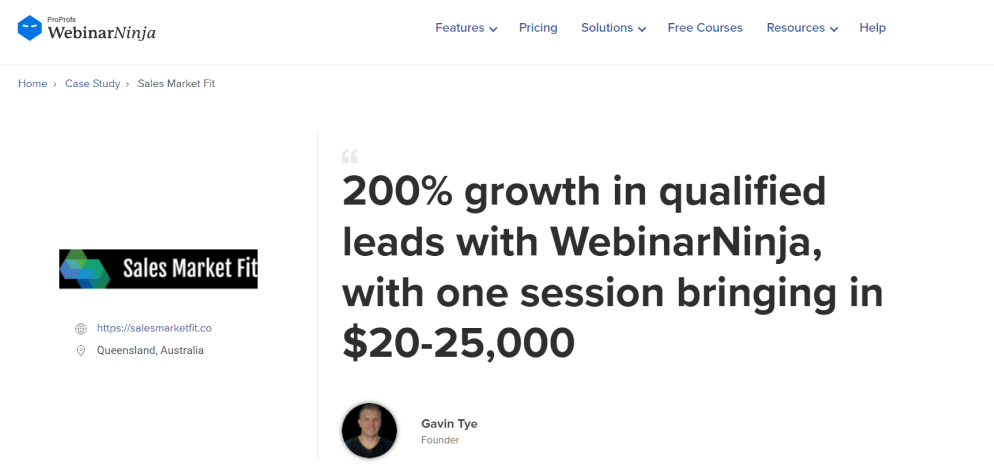
Case Study 2: “WebinarNinja provides excellent value with seamless service, offering a reliable and consistent experience!”
Michael Lancto, a certified financial educator, was looking for a cost-effective way to attract new clients and grow his business. Traditional marketing methods were expensive and had low engagement rates, so he needed a strategy that would allow him to connect with potential clients in a more meaningful way.
The Strategy
- Launched Live Financial Education Webinars – Instead of relying on cold outreach, Michael used webinars to educate potential clients about financial planning, positioning himself as a trusted expert.
- Designed Interactive and Value-Packed Sessions – The webinars were structured to provide immediate value, build trust, and encourage attendees to take action.
- Built a Lead Nurturing Funnel – Attendees who showed strong engagement during the webinar received follow-up content and consultation offers.
- Used a Consistent Webinar Schedule – Rather than running one-off events, Michael hosted webinars regularly, creating a reliable lead generation system.
The Results
- Increased revenue by 30% through webinar-driven client acquisition.
- Built a predictable flow of qualified leads without expensive advertising.
- Strengthened brand credibility and positioned himself as an industry leader.
Key Takeaway: Consistency is key. Hosting regular virtual events rather than one-time webinars creates a sustainable lead generation system and helps build long-term credibility.
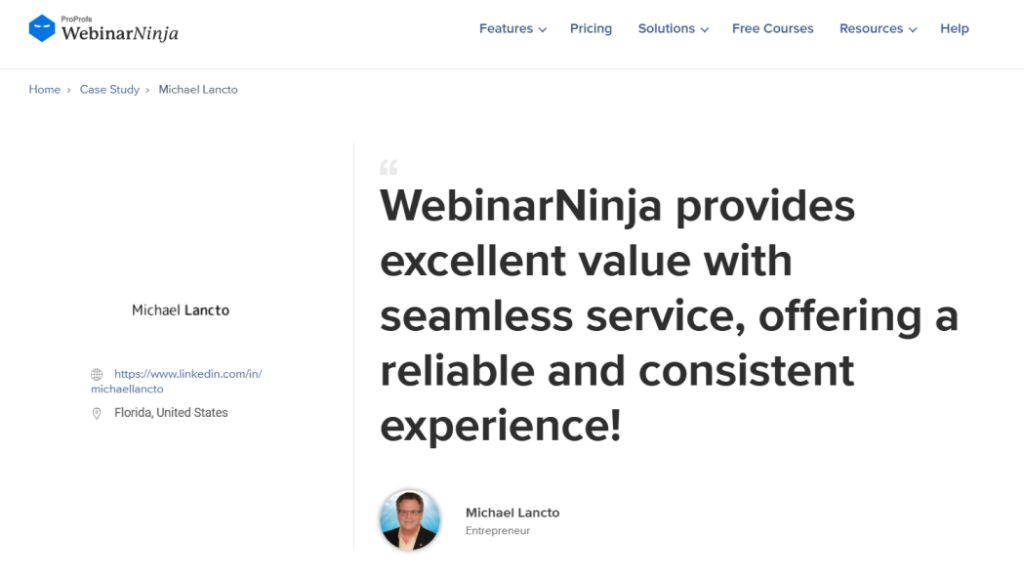
Overcoming Common Challenges in Scaling Virtual Events
While virtual events offer immense potential, scaling them effectively presents its own set of challenges. Many organizations struggle with low engagement, lead conversion issues, technology integration, and proving long-term ROI.
Check out the graph below. These are some of the most common challenges that people face when hosting virtual events, as compared to in-house events:
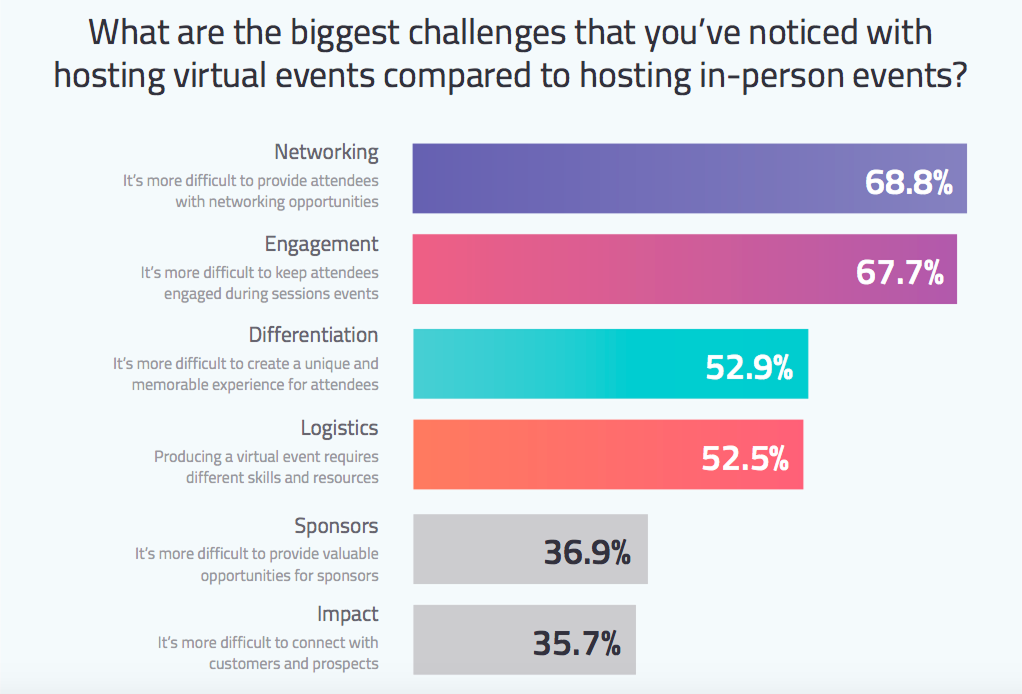
(Image Source: Campaign Asia)
If these challenges aren’t addressed, even the most well-planned events can fail to deliver meaningful business outcomes.
Here are the most common obstacles businesses face when scaling virtual events, along with practical solutions to overcome them.
1. Low Attendance Rates: More Sign-Ups, Fewer Attendees
One of the most frustrating challenges in virtual events is high registration numbers but low attendance. Many people sign up but don’t show up, either because they forget, lose interest, or get distracted.
Why This Happens:
- Lack of Pre-Event Engagement – Attendees sign up and then hear nothing until the event starts.
- No Urgency or Incentive – If there’s no clear reason to attend live, many prefer to watch a recording later (or not at all).
- Confusing Access Process – A complex login process or unclear instructions can lead to drop-offs.
How to Fix It:
✅ Increase Pre-Event Engagement – Send teaser content, polls, and speaker highlights before the event to keep interest high.
✅ Use Calendar Invites and Reminders – Automatically add the event to attendees’ calendars and send at least three reminders (24 hours, 1 hour, and 10 minutes before the event).
✅ Create a “Live Attendance” Incentive – Offer exclusive Q&A sessions, giveaways, or content that’s only available to live attendees.
✅ Simplify Event Access – Ensure attendees can join with one click (no complicated logins or extra steps).
2. Declining Engagement During the Event
Many virtual events start strong but see drop-offs mid-session. If attendees aren’t actively engaged, they’re likely to leave early or multitask in the background.
Why This Happens:
- Too Much Passive Content – One-sided presentations with no audience participation lead to boredom.
- Long, Unstructured Sessions – Virtual fatigue sets in when sessions are too long without breaks or variation.
- Lack of Interaction – If attendees don’t feel involved, they mentally check out.
How to Fix It:
✅ Start with Engagement – Ask a poll, question, or icebreaker in the first two minutes to grab attention.
✅ Keep Sessions Short and Focused – Aim for 30-45 minute sessions with engaging storytelling instead of lengthy slideshows.
✅ Use Multiple Engagement Tools – Incorporate live Q&A, chat discussions, breakout rooms, and gamification to keep participation high.
✅ Encourage Multi-Speaker Events – Changing speakers or using panel discussions makes content feel dynamic.
3. Low Conversion from Attendees to Leads or Customers
Many businesses attract large audiences to their virtual events, but few attendees turn into actual leads or customers.
Why This Happens:
- Lack of Clear Next Steps – Attendees enjoy the event but aren’t directed toward taking action.
- No Segmentation of Leads – All attendees are treated the same, even though some are much more engaged than others.
- Weak Follow-Up Strategy – A generic “thank you” email is not enough to convert attendees into sales opportunities.
How to Fix It:
✅ Have a Strong Call-to-Action (CTA) – Make sure every session ends with a clear CTA, whether it’s booking a demo, downloading a resource, or joining a follow-up session.
✅ Segment Attendees Based on Engagement – Identify high-intent attendees (those who asked questions, stayed until the end, or clicked links) and prioritize them for sales outreach.
✅ Send a Multi-Step Follow-Up Sequence – Follow up with attendees over several weeks with event highlights, additional resources, and personalized offers.
✅ Offer an Exclusive Post-Event Opportunity – Provide limited-time discounts, one-on-one consultations, or access to premium content for engaged attendees.
4. Technology & Integration Issues
Technical issues can ruin the virtual event experience for both attendees and organizers. Whether it’s poor video quality, platform crashes, or lack of integration with CRM tools, these problems can seriously hurt event ROI.
Why This Happens:
- Choosing the Wrong Platform – Not all virtual event platforms offer the features needed for a smooth experience.
- Poor Internet Connection or Audio/Video Quality – Technical glitches create frustration and cause attendees to drop off.
- Lack of CRM and Marketing Automation Integration – If event data isn’t captured in real-time, leads can slip through the cracks.
How to Fix It:
✅ Choose the Right Virtual Event Platform – Ensure the platform supports live interaction, analytics, and easy CRM integration.
✅ Test Technology Before the Event – Conduct a full run-through with all speakers to check audio, video, and screen-sharing quality.
✅ Provide Tech Support for Attendees – Have a dedicated support team or live chat for attendees who need help joining the event.
✅ Ensure Event Data Syncs with CRM – Use automation tools to instantly update lead data in CRM and marketing software.
5. Proving Long-Term ROI and Business Impact
Many organizations struggle to prove the real business value of their virtual events, making it harder to justify future investments.
Why This Happens:
- Focusing Only on Attendance Metrics – Measuring only registrations and live viewers doesn’t show business impact.
- Not Tracking Post-Event Engagement – If attendees engage with follow-up content or enter the sales pipeline months later, that impact may be missed.
- Lack of Attribution Models – Virtual events often influence revenue indirectly, making it difficult to track conversions.
How to Fix It:
✅ Use Multi-Touch Attribution Models – Assign revenue credit to virtual events based on their role in the sales journey.
✅ Track Engagement Beyond the Event – Monitor how many attendees download content, request demos, or engage with post-event emails.
✅ Measure Long-Term Impact – Instead of only looking at immediate conversions, track how many attendees enter the sales pipeline months later.
✅ Compare Virtual Event ROI to Other Marketing Channels – Show stakeholders how event-driven leads compare to leads from paid ads, email campaigns, and organic traffic.
Turn Your Virtual Events into High-ROI Powerhouses
Virtual events are no longer just an alternative to in-person gatherings—they are a strategic growth engine for businesses looking to expand their reach, generate leads, and strengthen customer relationships. But without a clear ROI strategy.
A well-executed virtual event doesn’t just generate attendees—it creates lasting business impact. But to make that happen, you need the right tools to manage, optimize, and track your virtual event success.
This is where a robust webinar platform like WebinarNinja can make all the difference. With built-in analytics, engagement tools, CRM integration, and automated follow-ups, WebinarNinja helps businesses not just host virtual events, but turn them into revenue-generating opportunities.
Now that you have the knowledge and strategies to maximize your virtual event ROI, it’s time to put them into action.
Want to host a webinar for free?
Use WebinarNinja to teach, improve marketing, and grow your sales.







